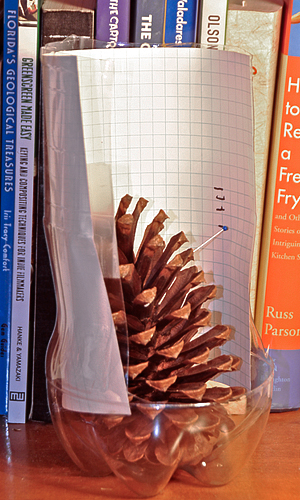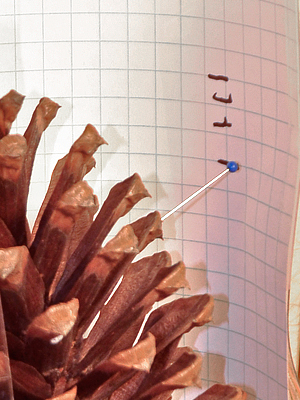Back in the dark ages, when I was in school, we used human hair to construct a hygrometer for measuring the humidity in the air. Since hair counts as "human tissue", many schools are not able to make hair hygrometers, but you can build a nice hygrometer using a pinecone instead of a hair.
To do this, you will need:
- a pine cone
- a straight pin
- a 2 liter bottle, small box, or other small container
- some glue
- a piece of paper
- tape
- a pen or marker


Start by looking closely at the pinecone. You will see that it is made up of many scale-like pieces connected together at a central core. These scales will move as the humidity changes, and we want to measure that movement.
Carefully stick the point of the straight pin into end of one of the scales, near the top of the cone. Cut the top off of the 2 liter bottle, and cut out one side, as shown in the photograph. Glue the base of the pinecone to the bottom of the bottle. Cut a sheet of paper so that it will fit along the inside of the bottle, and tape it in place. This is where we will mark and measure the humidity.
Use the pen to mark the position of the head of the straight pin. This is our starting position. We don't know what humidity it represents yet, but it gives us a reference point. Place the pinecone outside, in a shady place where it will not be disturbed. If the weather is windy, you may need to support it with a few rocks or sticks. Let it sit outside overnight.
The next day, check your local weather, to see what the humidity reading is. Examine the pine cone hygrometer. You will probably notice that the head of the pin has moved. Mark its new position, and label it with the humidity reading from the local weather. Now we have a reference point with a known humidity. As the weather changes, continue marking the humidity each day. Soon, you will have your hygrometer calibrated with enough reference points to let you determine the humidity without having to check with the local weather report.
What is happening? The scales of the pine cone are there to protect its seeds. The pine cone produces one seed on the inner side of each scale. While the scales are closed, the seeds are safely protected inside. Many plants release their seeds as soon as they are mature, but pine cones let the pine tree be more selective.
Many pine seeds have a wing-like structure on one end, letting them twirl in the air like maple seeds. This lets them fall slower, letting the wind carry them farther away from the parent tree. This works best when the air is warm and dry. Moisture or rain will make the seeds heavier, so they would not travel as far. How can the pine cone wait for a warm, dry day before it releases its seeds?
The answer is in the structure of the cone's scales. When the air is humid, the outside of the scale absorbs moisture, and the outer cells expand. That bends the scale inwards towards the core to shut the pinecone. When the air is dry, the cells on the outer surface of the scale shrink, bending the scale outwards to open the cone and release the seeds. This only has to happen a few times to release all of the seeds, but the pine cone will continue to open and close as the humidity changes, letting us use it as a hygrometer.
